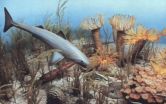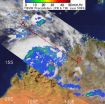(Press-News.org) An influx of invasive species can stop the dominant natural process of new species formation and trigger mass extinction events, according to research results published today in the journal PLoS ONE.
The study of the collapse of Earth's marine life 378 to 375 million years ago suggests that the planet's current ecosystems, which are struggling with biodiversity loss, could meet a similar fate.
Although Earth has experienced five major mass extinction events, the environmental crash during the Late Devonian was unlike any other in the planet's history.
The actual number of extinctions wasn't higher than the natural rate of species loss, but very few new species arose.
"We refer to the Late Devonian as a mass extinction, but it was actually a biodiversity crisis," said Alycia Stigall, a scientist at Ohio University and author of the PLoS ONE paper.
"This research significantly contributes to our understanding of species invasions from a deep-time perspective," said Lisa Boush, program director in the National Science Foundation (NSF)'s Division of Earth Sciences, which funded the research.&
"The knowledge is critical to determining the cause and extent of mass extinctions through time, especially the five biggest biodiversity crises in the history of life on Earth. It provides an important perspective on our current biodiversity crises."
The research suggests that the typical method by which new species originate--vicariance--was absent during this ancient phase of Earth's history, and could be to blame for the mass extinction.
Vicariance occurs when a population becomes geographically divided by a natural, long-term event, such as the formation of a mountain range or a new river channel, and evolves into different species.
New species also can originate through dispersal, which occurs when a subset of a population moves to a new location.
In a departure from previous studies, Stigall used phylogenetic analysis, which draws on an understanding of the tree of evolutionary relationships to examine how individual speciation events occurred.
She focused on one bivalve, Leptodesma (Leiopteria), and two brachiopods, Floweria and Schizophoria (Schizophoria), as well as a predatory crustacean, Archaeostraca.
These small, shelled marine animals were some of the most common inhabitants of the Late Devonian oceans, which had the most extensive reef system in Earth's history.
The seas teemed with huge predatory fish such as Dunkleosteus, and smaller life forms such as trilobites and crinoids (sea lilies).
The first forests and terrestrial ecosystems appeared during this time; amphibians began to walk on land.
As sea levels rose and the continents closed in to form connected land masses, however, some species gained access to environments they hadn't inhabited before.
The hardiest of these invasive species that could thrive on a variety of food sources and in new climates became dominant, wiping out more locally adapted species.
The invasive species were so prolific at this time that it became difficult for many new species to arise.
"The main mode of speciation that occurs in the geological record is shut down during the Devonian," said Stigall. "It just stops in its tracks."
Of the species Stigall studied, most lost substantial diversity during the Late Devonian, and one, Floweria, became extinct.
The entire marine ecosystem suffered a major collapse. Reef-forming corals were decimated and reefs did not appear on Earth again for 100 million years.
The giant fishes, trilobites, sponges and brachiopods also declined dramatically, while organisms on land had much higher survival rates.
The study is relevant for the current biodiversity crisis, Stigall said, as human activity has introduced a high number of invasive species into new ecosystems.
In addition, the modern extinction rate exceeds the rate of ancient extinction events, including the event that wiped out the dinosaurs 65 million years ago.
"Even if you can stop habitat loss, the fact that we've moved all these invasive species around the planet will take a long time to recover from because the high level of invasions has suppressed the speciation rate substantially," Stigall said.
Maintaining Earth's ecosystems, she suggests, would be helped by focusing efforts and resources on protection of new species generation.
"The more we know about this process," Stigall said, "the more we will understand how to best preserve biodiversity."
INFORMATION:
The research was also funded by the American Chemical Society and Ohio University.
What triggers mass extinctions? Study shows how invasive species stop new life
Collapse of Earth's marine life 378 to 375 million years ago holds key
2010-12-31
ELSE PRESS RELEASES FROM THIS DATE:
Was Israel the birthplace of modern man?
2010-12-31
Tel Aviv ― It has long been believed that modern man emerged from the continent of Africa 200,000 years ago. Now Tel Aviv University archaeologists have uncovered evidence that Homo sapiens roamed the land now called Israel as early as 400,000 years ago ― the earliest evidence for the existence of modern man anywhere in the world.
The findings were discovered in the Qesem Cave, a pre-historic site located near Rosh Ha'ayin that was first excavated in 2000. Prof. Avi Gopher and Dr. Ran Barkai of Tel Aviv University's Department of Archaeology, who run the excavations, ...
New technology to speed cleanup of nuclear contaminated sites
2010-12-31
CORVALLIS, Ore. – Members of the engineering faculty at Oregon State University have invented a new type of radiation detection and measurement device that will be particularly useful for cleanup of sites with radioactive contamination, making the process faster, more accurate and less expensive.
A patent has been granted on this new type of radiation spectrometer, and the first production of devices will begin soon. The advance has also led to creation of a Corvallis-based spinoff company, Avicenna Instruments, based on the OSU research. The market for these instruments ...
Risk for alcoholism linked to risk for obesity
2010-12-31
AUDIO:
Addiction researchers at Washington University School of Medicine in St. Louis have noticed an unexpected link between alcoholism risk and obesity. They report when a person has a genetic risk...
Click here for more information.
Addiction researchers at Washington University School of Medicine in St. Louis have found that a risk for alcoholism also may put individuals at risk for obesity.
The researchers noted that the association between a family history of alcoholism ...
GOES satellites watch 2011 approach, look back at 2010
2010-12-31
The GOES series of satellites keep an eye on the weather happening over the continental U.S. and eastern Pacific and Atlantic Oceans and had a busy time with wild weather in 2010. Today, GOES-13 captured one of the last images of North and South America in 2010 as the world continues to turn toward 2011.
The Geostationary Operational Environmental Satellite called GOES-13 satellite captured a "full-disk image" of North and South America in an image created December 30 at 1445 UTC (9:45 a.m. EST) as the world awaits the new year. The stunning image shows cloud cover associated ...
TRMM satellite sees system 98s raining on western Australia
2010-12-31
System 98S is currently bringing rains and gusty winds to the northwestern coast of Western Australia, and NASA's Tropical Rainfall Measuring Mission satellite spotted areas of moderate to heavy rainfall in the system.
NASA's TRMM satellite captured an image of System 98S' rainfall when it passed overhead in space on Dec. 30 at 1310 UTC (8:10 a.m. EST). TRMM is a joint mission between NASA and the Japanese space agency JAXA that can estimate rainfall in a tropical cyclone from its vantage point in space.The heaviest rainfall was occurring over the Southern Indian Ocean ...
Consistent exercise associated with lower risk of colon cancer death
2010-12-31
AUDIO:
It’s not news that exercise is good for your health, but scientists continue to learn more about just how beneficial regular exercise can be. Now a study led by researchers...
Click here for more information.
Consistent exercise is associated with a lower risk of dying from colon cancer, according to a new study led by researchers at the Siteman Cancer Center at Washington University School of Medicine and Barnes-Jewish Hospital in St. Louis. The study is among ...
Prompt Proofing Blog: New Year's Resolutions
2010-12-31
Happy New Year!
The New Year is all about new beginnings. I love the idea that, with every January 1 that rolls around, I can start with a clean slate - all previous mistakes and misjudgments are forgotten and the future me will be perfect in every way. (Of course this ideal doesn't generally last past January 2 but hey...)
OK, so maybe you won't always manage to lose 20lbs, pay off your credit card in full every month, call your mom once a week, go to the gym at 6:30 every morning etc. The following suggestions may, however, enable you to avoid unnecessary grammar ...
Get Organized! Professional Organizer to be Featured on Midday News
2010-12-31
Becky Esker, professional organizer and owner of Get Organized, LLC, located in Cedar Rapids, Iowa will be featured on KCRG-TV9 mid-day newscast Friday, December 31 at approximately 11:45 a.m. Becky is the forthcoming author of 2 Minute Organizing Miracles: Simple Secrets to Leading an Organized Life. Becky will show viewers "how to" tackle an organizing project and will give tips and tricks for success. Start 2011 off on the right foot by taking a few minutes out of your day to watch her demonstration. Then visit http://www.theorganizingchoice.com for even more information, ...
Semiconductor Markets in Europe - Brand-New Market Analyses
2010-12-31
Today, Global Research & Data Services is going to publish several market analyses about the semiconductor markets in Europe.
We make available the following brand-new market analyses:
Semiconductors - Germany
Semiconductors - Austria
Semiconductors - Belgium
Semiconductors - Bulgaria
Semiconductors - Czech Republic
Semiconductors - Denmark
Semiconductors - Estonia
Semiconductors - Finland
Semiconductors - France
Semiconductors - Greece
Semiconductors - Hungary
Semiconductors - Ireland
Semiconductors - Italy
Semiconductors - Latvia
Semiconductors - ...
Study Guide for the PMI Risk Management Professional Exam
2010-12-31
Abdulla J. ALkuwaiti Has introduced the first book to prepare candidates to take the new certificate titles: The Risk Management Professional. This certificate is awarded by the Project Management Institute in the USA, which is one of the most respected project bodies in the word.
The Author introduced a new method for studying which he calls "memorize then understand", where he present individual concepts of risk management for the reader to memorize and then combine them n the bigger context of Risk Management for the purpose of understanding. He argues that this approach ...
LAST 30 PRESS RELEASES:
First Editorial of 2026: Resisting AI slop
Joint ground- and space-based observations reveal Saturn-mass rogue planet
Inheritable genetic variant offers protection against blood cancer risk and progression
Pigs settled Pacific islands alongside early human voyagers
A Coral reef’s daily pulse reshapes microbes in surrounding waters
EAST Tokamak experiments exceed plasma density limit, offering new approach to fusion ignition
Groundbreaking discovery reveals Africa’s oldest cremation pyre and complex ritual practices
First breathing ‘lung-on-chip’ developed using genetically identical cells
How people moved pigs across the Pacific
Interaction of climate change and human activity and its impact on plant diversity in Qinghai-Tibet plateau
From addressing uncertainty to national strategy: an interpretation of Professor Lim Siong Guan’s views
Clinical trials on AI language model use in digestive healthcare
Scientists improve robotic visual–inertial trajectory localization accuracy using cross-modal interaction and selection techniques
Correlation between cancer cachexia and immune-related adverse events in HCC
Human adipose tissue: a new source for functional organoids
Metro lines double as freight highways during off-peak hours, Beijing study shows
Biomedical functions and applications of nanomaterials in tumor diagnosis and treatment: perspectives from ophthalmic oncology
3D imaging unveils how passivation improves perovskite solar cell performance
Enriching framework Al sites in 8-membered rings of Cu-SSZ-39 zeolite to enhance low-temperature ammonia selective catalytic reduction performance
AI-powered RNA drug development: a new frontier in therapeutics
Decoupling the HOR enhancement on PtRu: Dynamically matching interfacial water to reaction coordinates
Sulfur isn’t poisonous when it synergistically acts with phosphine in olefins hydroformylation
URI researchers uncover molecular mechanisms behind speciation in corals
Chitin based carbon aerogel offers a cleaner way to store thermal energy
Tracing hidden sources of nitrate pollution in rapidly changing rural urban landscapes
Viruses on plastic pollution may quietly accelerate the spread of antibiotic resistance
Three UH Rainbow Babies & Children’s faculty elected to prestigious American Pediatric Society
Tunnel resilience models unveiled to aid post-earthquake recovery
Satellite communication systems: the future of 5G/6G connectivity
Space computing power networks: a new frontier for satellite technologies
[Press-News.org] What triggers mass extinctions? Study shows how invasive species stop new lifeCollapse of Earth's marine life 378 to 375 million years ago holds key




